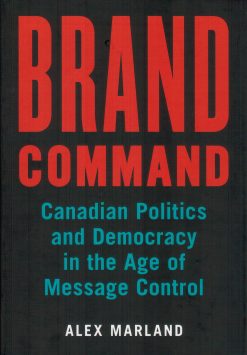Years ago a friend of mine, a defence contractor in a spot of trouble, asked: “How can I manipulate media?” It was a blunt, honest question deserving a response in kind. “You can’t,” I replied, not from any claim to newsroom virtue but in observance of Lincoln’s Law that nobody can fool all the people all the time. If public opinion was that malleable, every movie would be a blockbuster, every book a bestseller. every political candidate a winner. Focus group failure speaks for itself.
Yet the myth persists. The lure of manipulation as an expedient problem-solver is irresistible. As every gambler has a “system” so every bureaucracy has a “media strategy.” The practitioners are known as comms guys, communication directors.
Professor Alex Marland of Memorial University is a former comms guy. Brand Command is a compilation of conventional wisdom unexpected in what purports to be a scholarly work. Here are comms guys’ essential themes.
First, digital media are now so lightning-fast it almost defies human comprehension. “There are fewer gatekeepers, less verification of claims, more gossip, more noise and less time to think,” writes Marland. He cites the “turbulence brought by social media” and “cacophony of urgent demands.”
The same could be said of the underwater cable introduced in 1858, the launch of commercial radio (1920). first teletype (1927), the first affordable fax machine (1980). In the 1870s results of the Derby were telegraphed from London to Calcutta in 12 minutes flat. Media have sped along at an industrial pace ever since.
Brand Command further asserts corporate media are all-powerful. “Television still dominates Canadians’ primary source of news and information,” Marland writes. He quotes a fellow comms guy, “You used to be able to wait for a news story to develop. Now it’s not even a matter of it happens and then you respond.” A CBC executive says, “Everything’s changed because of the internet, the timing of things; news come out 24/7.”
In fact the audience for CBC-TV’s The National has fallen 50 percent in a generation. The network’s flagship all-news cable channel draws spot ratings of 85,000, a third the listeners of the AM radio station in my hometown.
Confronted by the Kung Fu spectre of rapid electronic media, Marland concludes politicians and comms guys are able to manipulate messages and public opinion itself. “Branded communications save time for both the sender and the receiver by simplifying information for a disparate audience,” Marland writes. “Complex topics are distilled into messaged themes”; “However, branding threatens idealized notions of democratic government and party politics. It harmonizes and dumbs down. It requires strict message control and image management. Above all, public sector branding contributes to the centralization of decision making within the prime minister’s inner circle.”
This was a timely thesis in 1953 when Liberal managers transformed Louis St. Laurent from a dour corporate lawyer into a silver-haired grandfather. Staffers even had St. Laurent pose on a swing with a toddler. The strategy didn’t save St. Laurent in a1957 election. Easy come, easy go. In 1965 “branders” told Lester Pearson to lose his trademark bowtie after focus group testing suggested it made the Prime Minister appear effete.
Still Brand Command stands fast. Readers are told media manipulation is hip, now, happening. Marland has a breezy style uncluttered by contradictory research. An example: “Containment of off-message remarks in Canadian politics is now an art form,” he writes, citing a 2014 statement by an MP that legislators should use miniature video cameras to “prevent besmirchment”: “Apparently the MP was so worked up into a state of paranoia about inopportune encounters destabilizing his personal brand and the party’s brand that his anxiety and poor judgment did just that,” Brand Command states. The incident raised questions “about the state of Canadian democracy in the digital age.”
This is demonstrably misleading. I knew the MP in question, libertarian Peter Goldring. In 2011 he was falsely charged by an Edmonton constable with impaired driving. Goldring suffered public embarrassment and expulsion from the Conservative caucus till his acquittal in 2013. Goldring liked mini-cams because he didn’t trust Edmonton police. The omission of these facts by Professor Marland is striking.
By Tom Korski
Brand Command: Canadian Politics and Democracy in the Age of Message Control, by Alex Marland; University of British Columbia Press; 528 pages; ISBN 9780-7748-32038; $39.95








